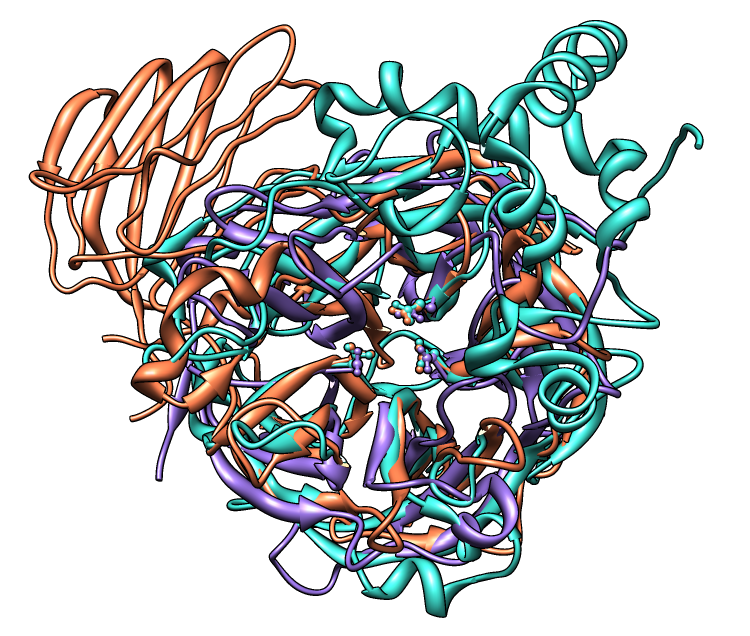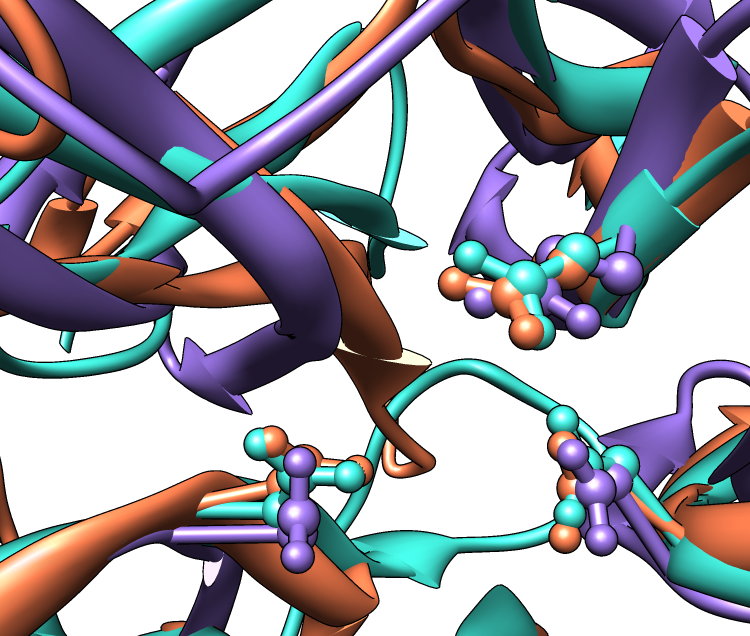

This tutorial describes superimposing structures, saving positions and sessions, and creating publication-quality images. The process described here is only one of many possibilities. Internet connectivity is required to fetch the structures 1uyp, 1gyd, and 1oyg.
See also: presets, tips on preparing images, and on the Chimera Web site, the Image Gallery
Glycoside hydrolases (GH) are a large, heterogeneous set of enzymes that hydrolyze bonds between sugars and other groups. Based on sequence comparisons, these enzymes have been categorized into many families; see the CAZy web site for details.
This tutorial describes the creation of images to show
structural similarities among members of GH families 32, 43, and 68.
These enzymes were grouped into different families because their
similarities were not evident from sequence comparisons.
Three acidic residues are at the active site of a beta-propeller architecture
in glycoside hydrolase families 32, 43, 62, and 68.
Pons T, Naumoff DG, Martínez-Fleites C, Hernández L.
Proteins. 2004 Feb 15;54(3):424-32.
The three-dimensional structure of invertase (beta-fructosidase)
from Thermotoga maritima reveals a bimodular arrangement and an
evolutionary relationship between retaining and inverting glycosidases.
Alberto F, Bignon C, Sulzenbacher G, Henrissat B, Czjzek M.
J Biol Chem. 2004 Apr 30;279(18):18903-10.
On Windows/Mac, click the chimera icon. On UNIX, start Chimera from the system prompt:
unix: chimeraA basic Chimera window should appear after a few seconds; resize it as desired. Open the Command Line (choosing Tools... General Controls... Command Line is one way).
If you have internet connectivity, structures can be obtained directly from the Protein Data Bank. Choose File... Fetch by ID from the Chimera menu. In the resulting dialog, check the PDB option (if it is not already checked) and the option to Keep dialog up after Fetch. Fetch the PDB structures 1uyp, 1gyd, and 1oyg, in that order, and then Close the dialog.
Some salient features of these structures:
| PDB ID | enzyme | family | chains | conserved residues | model # in Chimera | ||
|---|---|---|---|---|---|---|---|
| 1uyp | invertase, T. maritima |
GH32 | A-F | Asp17 | Asp138 | Glu190 | 0 |
| 1gyd | arabinanase A, C. japonicus |
GH43 | B | Asp38 | Asp158 | Glu221 | 1 |
| 1oyg | levansucrase, B. subtilis |
GH68 | A | Asp86 | Asp247 | Glu342 | 2 |
Simplify the situation by deleting unwanted (for our purposes) portions of the structures such as extra chains and solvent:
Command: delete #0:.b-fMove and scale the structures as desired throughout the tutorial.
Command: delete solvent | ligand | ions
Choose Presets... Interactive 1 (ribbons) from the menu. Styles of ribbon include flat, edged, and as used in the preset, rounded.
Command: ribrep flatCustom ribbon styles and scalings (secondary-structure-specific heights and widths) can be created with the Ribbon Style Editor (Tools... Depiction... Ribbon Style Editor).
Command: ribrep edged
Command: ribrep rounded
Although the examples show ribbons for the entire chains, each residue's ribbon segment can be shown or hidden. For example, the following hides ribbons for the C-terminal domain of the first structure (model 0):
Command: ~ribbon #0:296-endA command without residues specified affects all residues:
Command: ribbon
Since a set of structurally equivalent residues is known, an efficient way to superimpose the structures is by specifying atoms to use in a least-squares fit. The match command requires equal numbers of atoms from the two models being matched. The following specifies the backbone atoms N, CA, C, O in each conserved residue:
Command: match #1:38,158,221@n,ca,c,o #0:17,138,190@n,ca,c,oModel 0 (invertase) was used as the reference structure for both pairwise matches. The chains did not need to be specified because each model only has one chain (chains B-F were deleted from model 0). Chain identifiers are needed to specify residues uniquely when the same residue number occurs in more than one chain in the same model. The number of points used for fitting and the resulting RMSD values are reported in the Reply Log.
Command: match #2:86,247,342@n,ca,c,o #0:17,138,190@n,ca,c,o
Alternatively, matchmaker could have been used to superimpose the structures:
Command: mm #0 #1This uses the protein sequences and secondary structure assignments to generate alignments, then fits the CA atoms of the aligned pairs. See superimposing structures for more discussion of the different methods.
Command: mm #0 #2
Select the conserved residues:
Command: select #0:17,138,190 #1:38,158,221 #2:86,247,342The atom specification should not contain spaces except (optionally) before the model symbols #.
Show only those atoms/bonds, and use the ball-and-stick style:
Command: show selEven though all atoms of the residues are "displayed," by default the backbone atoms are hidden when ribbon is shown (this can be controlled with the command ribbackbone).
Command: repr bs sel
Command: ~sel
The background can be any color, but white is often best for publication.
Command: set bg_color whiteOther ways to change the background color are with the Actions... Color menu, the Background preferences, or presets. Presets change several display settings at once.
Choose a different color for each model:
Command: sel #0Repeat for models 1 and 2. For the example images, the colors named coral, medium purple, and turquoise were chosen for models 0, 1, and 2, respectively.
Actions... Color... all colors [pick a color]
Clear the selection:
Command: ~sel
Resize the Chimera window to the desired aspect ratio and find view(s) suitable for the images. A view or position refers to the locations and orientations of the structures, the overall scale, and the positions of the clipping planes.
For the example images, a position was found that showed the overall structures well, and when scaled up (without further rotation) showed the conserved side chains well. The zoomed-out position was named overall and the scaled-up position was named closeup:
Command: savepos overallSaved positions are included in saved sessions and can be regenerated:
Command: scale 4
Command: savepos closeup
Command: reset overallThese positions were used for the example images.
Command: reset closeup
Depth cueing is front-to-back shading of the scene, which looks like "fog" when the depth cueing color is light. By default, the depth cueing color automatically matches the background. Turn off depth cueing to remove the fog effect:
Command: ~set depth_cueThe stick, ball-and-stick, sphere, and ribbon display styles are made up of planar facets. The coarseness of the facets is controlled by the subdivision quality parameter, which ranges from 1 (default) to 20. Make the ribbons, atoms, and bonds smoother by increasing subdivision quality to 5:
Command: set subdivision 5Silhouettes are outlines that highlight boundaries and discontinuities. Turn on silhouettes and adjust their width to 1.5:
Command: set silhouetteThe silhouettes look rough in the Chimera window, but they will be smooth in the saved images due to supersampling. Depth cueing, subdivision quality, and silhouettes can also be controlled in the Effects tool (Tools... Viewing Controls... Effects). Silhouettes and increased subdivision quality may degrade interactive response; if so, adjust these settings last before saving sessions and images.
Command: set silhouette_width 1.5
A session file can be saved with File... Save Session As (in this case, images.py was saved). It is generally prudent to save sessions for publication images, as this decreases the labor necessary if figures have to be redone. Often minor adjustments such as changing a color or displaying a different set of side chains will be required.
Later, the session can be restarted with File... Restore Session. Any positions that were saved before the session was saved can be regenerated with the command reset.
Choosing File... Save Image brings up the Save Image panel.
Supersampling refers to generating an initial image larger than that requested and then sampling it down to the final size. This smooths edges within the image. The default Supersample setting of 3x3, used for the examples, is generally sufficient for publication.
Maintain current aspect ratio means that if the size along one dimension (width or height) is changed, clicking the entry field for the other dimension will automatically update its value according to the current aspect ratio of the graphics window. The dimensions can be specified directly in pixels, or in units of length (when Use print units is on). If units of length, the output pixel dimensions are calculated using the specified Print resolution.
To make an image for a single-column width of 85 mm (3.346 in) with a resolution of at least 300 dpi, possible approaches include:
The example images were saved in PNG format; other possibilities are TIFF, JPEG, PS (PostScript), and EPS (Encapsulated PostScript).